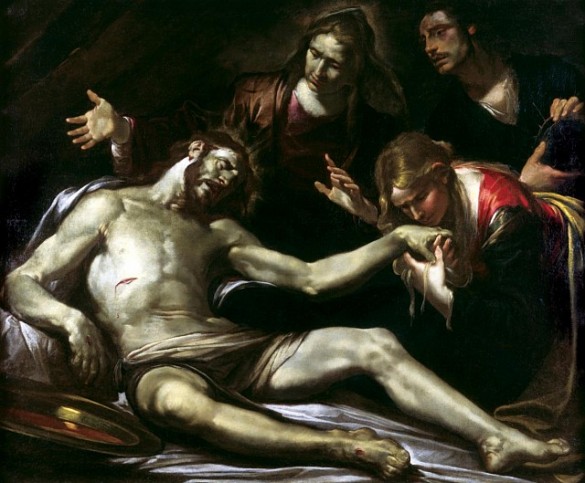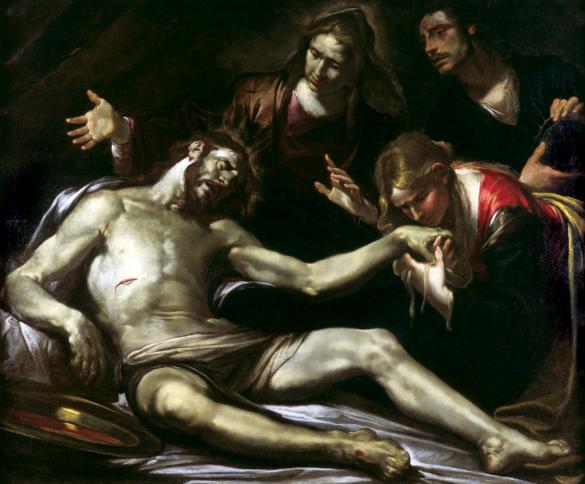Gioacchino Assereto: The Lamentation http://t.co/NprahSqF
Gioacchino Assereto: The Lamentation https://t.co/N…
by Cummer Museum Admin, Director of Art Education in
In the Gallery – Gioacchino Assereto: The Lamentation
by Curatorial Intern, in Art
Written by Allie Gloe, Curatorial Intern

Gioacchino Assereto (Italian, 1600 - 1649), The Lamentation, c. 1640, oil on canvas, 50 x 62 in., Purchased with funds from The Cummer Council, AP.1988.1.1.
Italian Baroque artist Gioacchino Assereto was born in 1600 in Genoa, France, where he began his training at the studio of Andrea Ansaldo at the early age of fourteen. Throughout the decade in which he was a student, Assereto produced many works close in style and genre. Typical of baroque style, Assereto incorporated drama and emotion in his paintings (almost all of a religious genre) with the aid of the chiaroscuro and sfumato techniques. He continued to improve his technique and style during his twenties and thirties, but it wasn’t until 1639, when he visited Rome, that he discovered a flourishing interest in realism. A year later, Assereto painted The Lamentation.
A common subject of Baroque painting, The Lamentation depicts a dead Christ after his broken body is removed from the cross, along with those who mourn over him. Assereto’s interpretation of The Lamentation is exceptionally powerful. He paints Christ’s flesh as if it has been stripped of pigment. The black background and intense shadows highlight Christ’s body which practically shimmers in the darkness, alluding to His holiness even after death. Assereto renders the Virgin Mary’s face in the same manner, which allows the viewer to understand her deep sorrow. She holds her hands out near Christ’s shoulders while Mary Magdalene gently raises Christ’s hand to her face and Saint John holds the crown of thorns. Assereto’s Lamentation is rich with emotion and offers the drama we look for in Baroque art.
#40 Gioacchino Assereto: The Lamentation
by Curatorial Intern, in Art
This dramatic tableau was meant to fulfill the Counter-Reformation Catholic Church’s doctrine that art was to “sting the heart,” making the viewer see and feel every aspect of the life and death of Christ. Here, the greatly foreshortened pallid body of Christ forms a diagonal that draws the viewer into the midst of the emotional scene, completing the circle of mourners. The play of dark shadows and bright highlights over the surface of the painting theatrically intensifies the sorrow-filled moment. Gioacchino Assereto’s Lamentation depicts Christ descended from the Cross and laid upon a cloth on the ground. Mourning him are the Virgin Mary who is near his head, Mary Magdalene who kisses his hand in a penitent gesture, and St. John the Evangelist who holds the crown of thorns.
Assereto worked in Genoa, Italy and specialized in painting religious subjects. He visited Rome in 1639 where he experienced firsthand the burgeoning interest in realism. This work is one of the very few paintings by Assereto found outside of Italy. Most of his paintings are still in the churches and palazzi for which they were originally commissioned.
“It depicts mother and child relationship and how a mother genuinely loves her son.” – anonymous
Keep an eye out every week for more visitor favorites. We will be highlighting each of the top fifty pieces during our 50th Anniversary year. If you want a more intimate encounter, stop by the museum and see these masterpieces for yourself!
Do You Know The Cummer?
by Amber Sesnick, Marketing Manager in Art
 How well do you know The Cummer? If you think you can identify these items—currently on display throughout the Museum as 50 Favorites. Write your guesses in the comment section below and we will give the answers in two weeks, along with the next challenge. One winner will receive a complimentary one-day pass to the Museum. Good luck!
How well do you know The Cummer? If you think you can identify these items—currently on display throughout the Museum as 50 Favorites. Write your guesses in the comment section below and we will give the answers in two weeks, along with the next challenge. One winner will receive a complimentary one-day pass to the Museum. Good luck!
Feb. 2, 2011 Answers!
#1: Gioacchino Assereto (Italian, 1600 – 1649), The Lamentation (The Pieta), c. 1640, oil on canvas, 50 x 62 in., Museum purchase with Council funds, AP.1988.1.1.
#2: Paulus Bor (Dutch, 1601 – 1669), Allegory of Avarice (The Miserly Woman), 17th century, oil on canvas, 48 x 39 3/8 in., Bequest of Ninah M. H. Cummer, C.0.128.1.
#3: Art Connections Interactive Center, 2010. Photograph courtesy of Ingrid Damiani
#4: Master of the Stötteritz Altar (German, active late 15th century), Mother of Sorrows, c. 1480, oil on panel, 8 ¾ x 6 ½ in., Gift of Mrs. Clifford G. Schultz in memory of Mr. Clifford G. Schultz, AG.1984.1.1.
Sign Up for our email Newsletter
Categories
- Art
- Behind the Scenes
- Community
- Cummer Amelia
- Cummer Beaches
- Cummer CAFÉ
- Cummer SHOP
- Education
- Gardens
- Podcast
- Programs
- Support
Connect with Us
Keep up with us on Facebook and Twitter to see what we're doing on other parts of the web!
Leave Us A Review
Did you have a great experience at The Cummer Museum & Gardens or the Tree Cup Cafe? Write a review or leave a fun tip on Yelp, TripAdvisor or FourSquare.
@thecummermuseum On Twitter
Recent Tweets
- Don’t miss a FREE recital from two members of the Ritz Chamber Players! ow.ly/Wh4L9 https://t.co/9BuWi2pVLI 8 years ago
- Need to get out of the house? Pay a visit to “The Newcomb Pottery Enterprise”. The show closes January 3rd! 8 years ago
- We love our Docents! Thank you Susan Law for your hard work! ow.ly/Wh3Jw 8 years ago
- Did you see the Folio Weekly article on the Outings Project? ow.ly/W2JxS 8 years ago
- #TBT to last month when Julien de Casabianca was in Jacksonville for the Outings Project! ow.ly/VYDBS 8 years ago
Powered by Tools for Twitter




